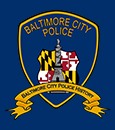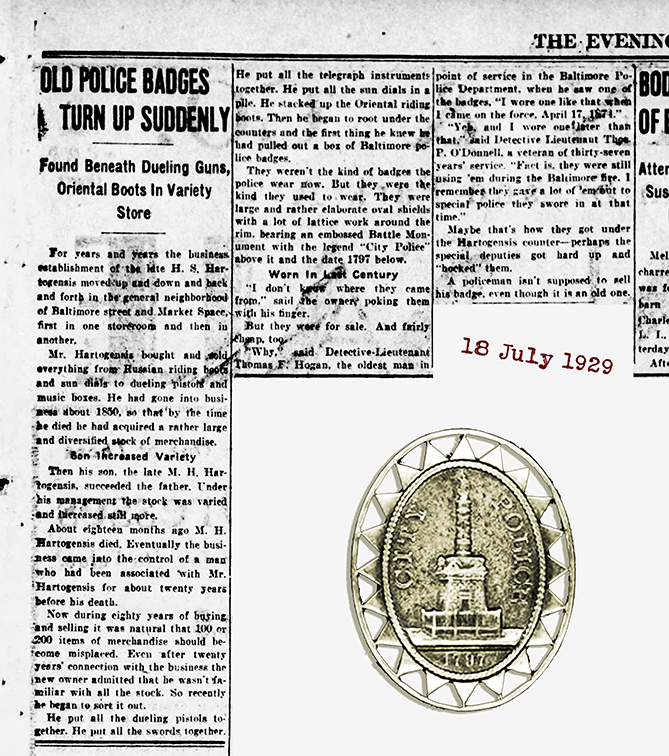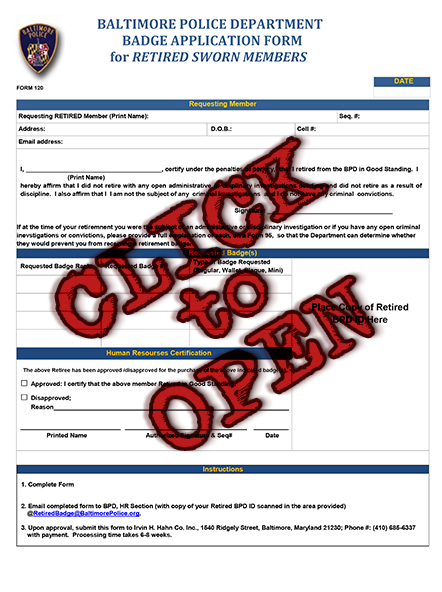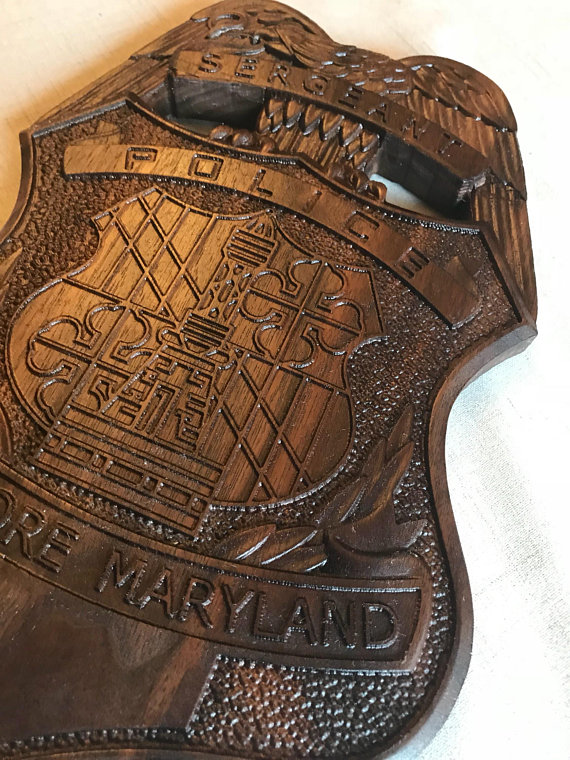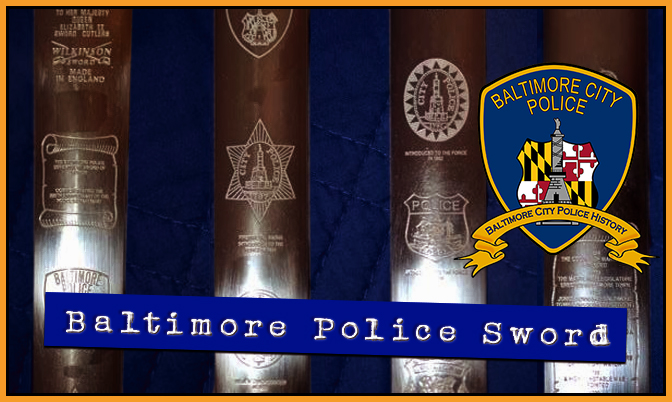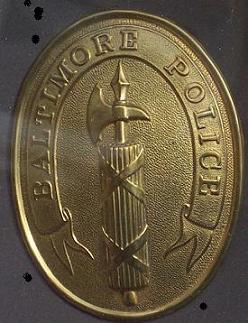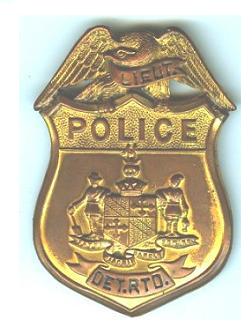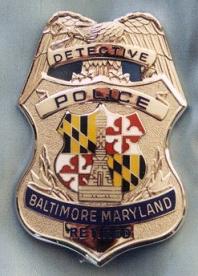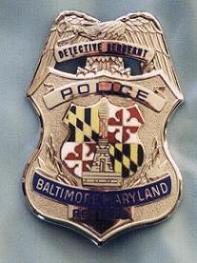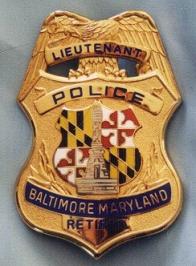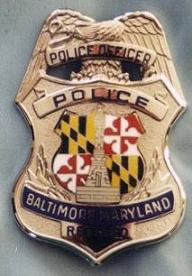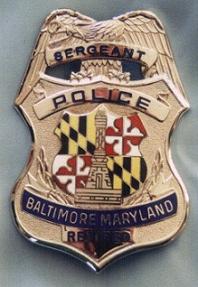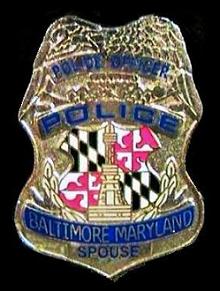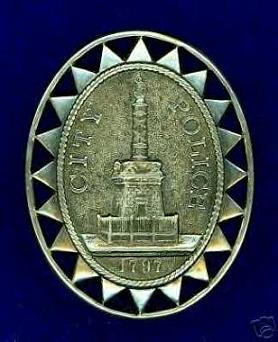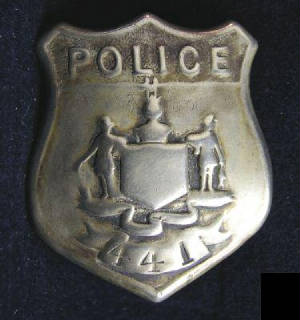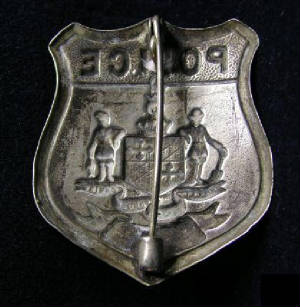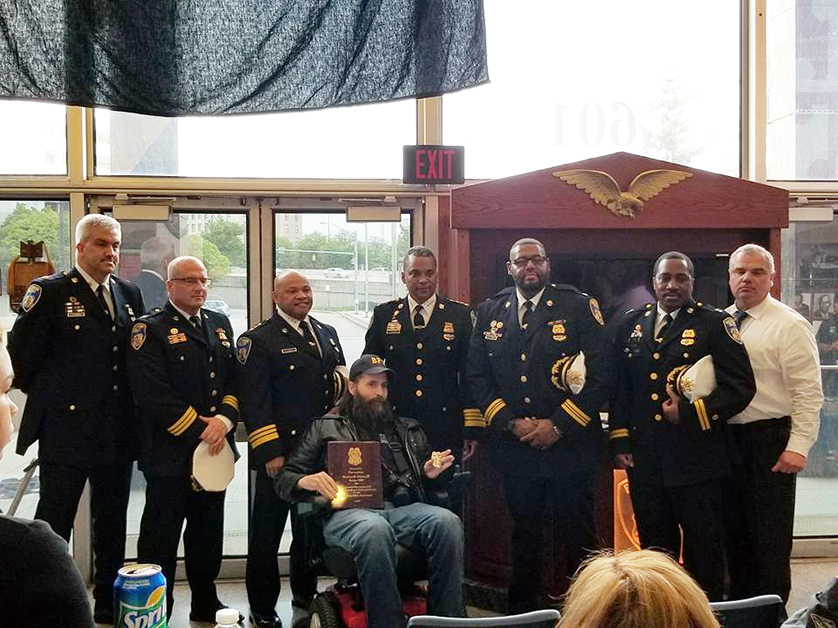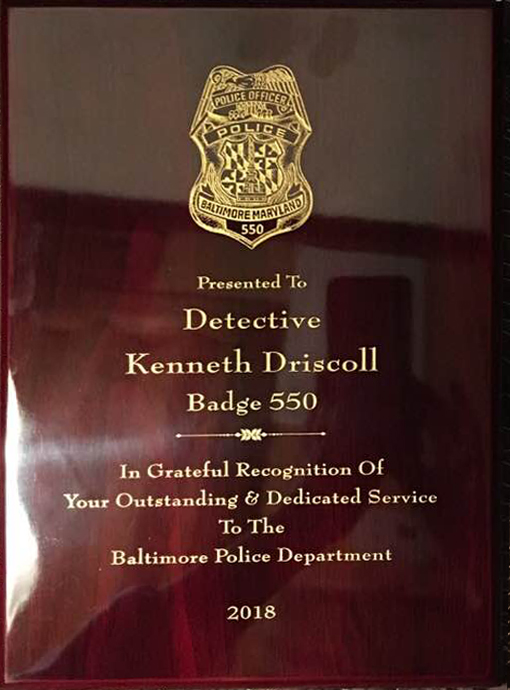Badges
Pink Ribbon – 1861 During a transition in the rebuilding of our police department, new uniforms and badges weren't yet designed. While waiting for said designations, the Baltimore Police dressed in plain clothes and were distinguished as police by a simple pink ribbon on their left lapel and an espantoon in their hands.
Baltimore City Police Badges
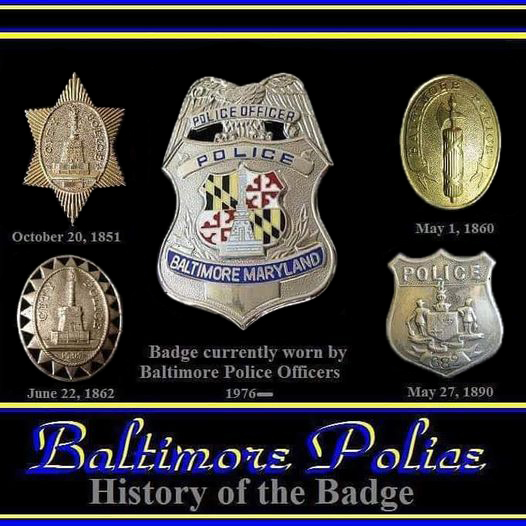 The Official Motto of the Department
The Official Motto of the Department
Established on November 9, 1880
"Semper Paratus, Semper Fideles, Ever on the Watch"
"EVER READY - EVER FAITHFUL"
"EVER ON THE WATCH"

CLICK ON THE FOLLOWING LINKS
Badge Collection - Patch Collection - BPD Helmets / Hats
BPD Patches - Known Badge Numbers - Novelty Custom Badges
![]()
BPD Badges 1851-Present
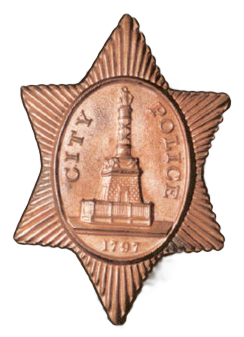
1ST. ISSUE
On October 20, 1851, the first known metallic badge worn by Baltimore Police Officers - a large six-pointed star with Baltimore's official city seal, the War of 1812 "Battle Monument" over the year 1797 (the year Baltimore City was incorporated), in an oval center. Within this oval center, across the top and sides, are the words "City Police.". Reissued in 1997 to celebrate our 200th anniversary, officers purchased this badge and wore it for that year. On April 11, 1853, Boston made a similar badge based on the Baltimore badge.
Click HERE to see the Boston Badge
From a Baltimore Sun Article dated - 21, 1851
The Stars – The badge designed to be worn by the city police was designed yesterday (Monday, October 20, 1851) by Messra. Mckinley and Callaway, who are in special attendance at the hall of the Maryland Institute. It consists of a heavily gilded, brightly burnished six-point star, in the center of which is seen a correct representation of the Battle Monument, surrounded by the words “City Police" and underlined with the date "1797," the date of our city’s charter. The star is worn on the left lapel of the coat and is so conspicuous that whoever runs may read it.
![]()
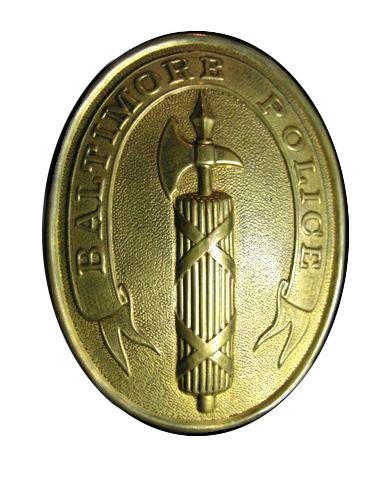
2nd. ISSUE
On May 1, 1860, a new "Metropolitan Police" force under a Board of Police Commissioner's (BOC), state-appointed civilians signaled the retirement of the "Corporation Police Force." A new badge was authorized. This large oval badge has Roman "fasces" and an ax bound by wooden rods as its central symbol. Across the top and sides of the "fasces" is a banner with the words "Baltimore Police" in raised letters.
![]()
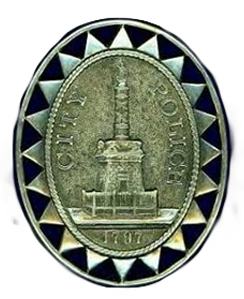
3rd. ISSUE
On June 22, 1862, a newly formed police force appeared in a completely new uniform with a new series of badges. With the same center section of the first badge and returning the designation of "City Police," surrounded by twenty small points encircled by a narrow rim. NOTE: The 20-pointer was replaced by an order from the Commissioner. He said, "Too many were in the hands of the citizens." (Stated in an article in the paper from 1890.) This badge had meaning, as in Baltimore from 1846 to 1887, we had 20 wards, a point for every ward, and a thin band around to represent the police that protects and holds it all together.
![]()
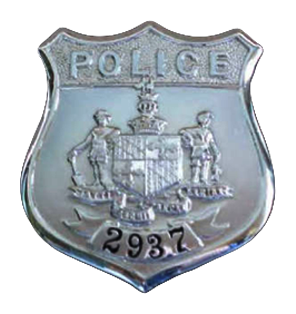
4th. ISSUE
May 27, 1890, was worn with a new uniform by all members of the force. This is a shield-shaped badge with the word "POLICE" across the top, the Maryland seal in the center, and a ribbon with the officer's number across the bottom. Sergeant's and above had an eagle on top of the shield. Lieutenants and above wore a badge gold in color. The eagle on the badges had a ribbon in its beak, denoting the rank of the officer.
You might have noticed the Maryland flag doesn't show up on a badge until this issue of our badge. It was once said it was because this was around the time the state took over management of the Baltimore Police. That could be part of it; however, the Maryland flag as we know it wasn't developed until after the Civil War; actually, sometime around 1880 would be the first time it was recognized as our state flag, and it wasn't our official flag until much later. So, we didn't see it earlier because, prior to the civil war, it did not exist. Read more about it HERE
![]()
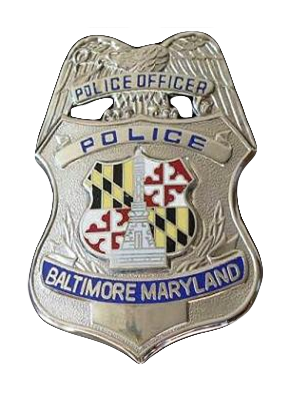
5th. ISSUE
4 April 1976: badge currently worn by Baltimore Police Officers. With the exception of the Series 2 badge, the word Baltimore did not appear on any official police badges. The Series 5 badge is similar to the Series 4 supervisor badge, with a new center seal that is the same as the one worn on the patch. Police officers and supervisors wear the same badge, with the ribbon in the eagle's beak denoting the rank. Lieutenant's and above wear the same badge that is gold in color.
The 5th issue badge that is currently worn by BCPD was designed by Robert DiStefano, now a retired BPD Major. He made the drawings that were submitted to the committee for approval and, subsequently, to the manufacturer.
Police Commissioner Donald D. Pomerleau was given two designs that he had drawn: one that was more of an oval badge and the one that he personally liked. He designed the current badge to be somewhat "different" than the classic "Eagle on Shield" design.
He says he purposely made the eagle's wings too high in proportion and squared off, sort of boxy. He wanted the committee to pick the oval, but he lost!
Police Commissioner Pomerleau like the "traditional" "Eagle on Shield." That's how we lost a really nice looking, more modern badge. He says that the chosen design grew on him!
He also worked on the design team that did the Departmental Sword. Along with Sergeant Bill Stone, he worked on the etchings for the blade. He was in Colonel Karner's office when he met with representatives of Wilkinson Sword. He has sword #4. 1976—April 4, 1976—the 5th. The issue badge appeared and is still the badge that Baltimore police officers wear today. With the exception of the 2nd Issue badge, the word Baltimore did not appear on any other official police badge. The 5th Issue badge is similar to the 4th Issue "Supervisor's" badge with a new center seal that is the same as worn on the large shoulder patch and considered our official department emblem.
![]()
20 Point Badges Found in a Most Unusual Location
Click HERE or article above to see full-size image
![]()
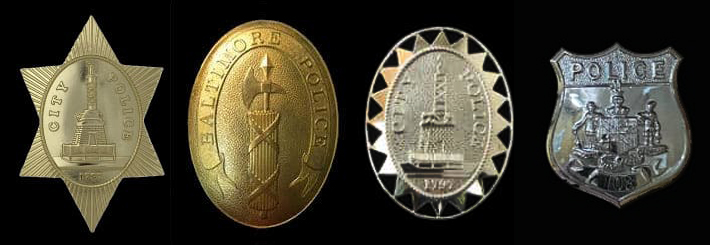 Buy a set of 1 thru 4 Issue badges direct from Irvin H. Hahn
Buy a set of 1 thru 4 Issue badges direct from Irvin H. Hahn
Click HERE or on the ad above![]() Policy 1501
Policy 1501
![]()
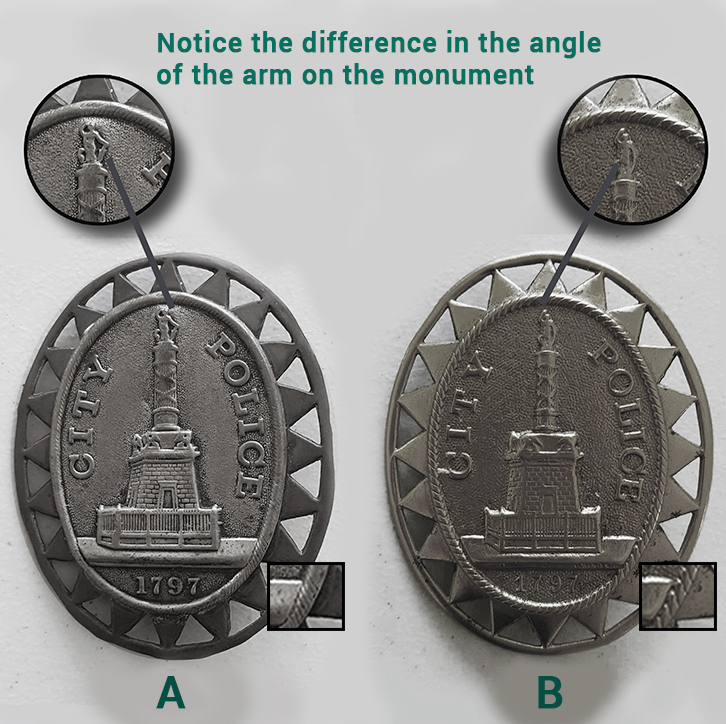
Seeger & Gminder versions of the 3rd Issue Badge
Badge A - In the 1862 Seeger Version the Statue's arm is bent at a wide angle away from her body
The Seeger Die is made from two pieces, and if you look close at the base of the monument you'll find no words or names. Also, the angle of the monument is a slightly different it almost looks larger than the Gminder version. Two more points to notice, in this version the rope that goes around the monument, inside the 20 points has tighter strands giving more detail to the rope, and the number 1797 are a different font, look at the number "1" on the 1797 and you'll see this one is flat whereas the other has a serif type tail coming from it. The last thing to look at is the stippling behind the monument, this one has a smooth consistent stippling, where badge B has an inconsistent tooling pattern.
Badge B - In the 1870's Gminder Version the Statue's arm is held at an angle more tight to her body
The Gminder Die was made in one piece, and in you look close you'll find two words, on the left "Jacob," and on the right "Gminder." The angle of this monument seems smaller, almost as if it is further away. Two more points to notice, in this version the rope that goes around the monument, just inside the 20 points has wider strands giving less detail to the rope, and the number 1797 is a different font, look at the top of the number "1" in this version (Badge B) there is a serif type tail coming from the top and front of the number 1, whereas the other has a smaller almost flat front. Now let's look at the background of both badges, Badge A has a fine consistent stippling, while this badge (Badge B) is a more handworked heavily tooled creating a less consistent pattern.
![]()

Above it the 4th Issue badge if you look at the badge you'll see in badge #1 the fisherman's side you'll see he is leaning cleanly against the escutcheon, wherein the #2 badge the fisherman appears to be leaning on some sort of box or added ledge This dates the badge, any badge that falls into the group looking like badge #1 was made between 1890 and 1936. - Badge number falls between 1936 and 1976 when they came out with the 5th Issue badge. The ledge was made in 1936 after the mold cracked, and the ledge was added when they made repairs to the mold
Badges made from 1890-1936 and 1936-1940's. The 1890's have a difference in the die, after 1936, there was die change which is quite minute. On the first die, Badge #1 the figure on the right (The Fisherman) of the coat of arms has his elbow resting cleanly on the top corner point of the escutcheon, whereas on the second die Badge #2, everything is the same with the exception of the fisherman's elbow which appears to be leaning on some sort of box, or added ledge below supporting his arm. That ledge/box was added due to a die or mold break/fracture that occurred in 1936. Also on the upper ranking badges, Sgt on up there was an eagle atop the badge, with a ribbon in his bill that revealed his rank. From 1890-1940's, that eagle was applied separately, after the 1840's the badges have a flatter less detailed eagle.
*Information provided by Police memorabilia collector Steven Rosenstock
![]()
Have a Wooden Badge Made
Click the word HERE or the pic above to go to the page
![]()
The Maryland Coat of Arms first made its appearance on the Baltimore Police badge on 20 Aug 1886 - below is more information on that coat of arms
The reverse (at right) consists of an escutcheon, or shield, bearing the Calvert and Crossland arms quartered. Above are an earl's coronet and a full-faced helmet. The escutcheon is supported on one side by a farmer and the other a fisherman. It symbolizes Lord Baltimore's two estates: Maryland, and Avalon in Newfoundland. The Calvert motto on the scroll is "Fatti Maschii Parole Femine," which is usually translated " Manly Deeds, Womanly Words." The Latin legend on the border (the last verse of Psalms 5 from the Vulgate) is translated "with favor wilt thou compass us as with a shield." The date, 1632, refers to the year the Maryland charter was granted by Charles I, King of England, to Cecilius Calvert, second Lord Baltimore. The obverse (left) of the Seal shows Lord Baltimore as a knight in full armor mounted on a charger. The inscription translated is "Cecilius, Absolute Lord of Maryland and Avalon, Baron of Baltimore."
Photos courtesy of Retired Major Robert DiStefano
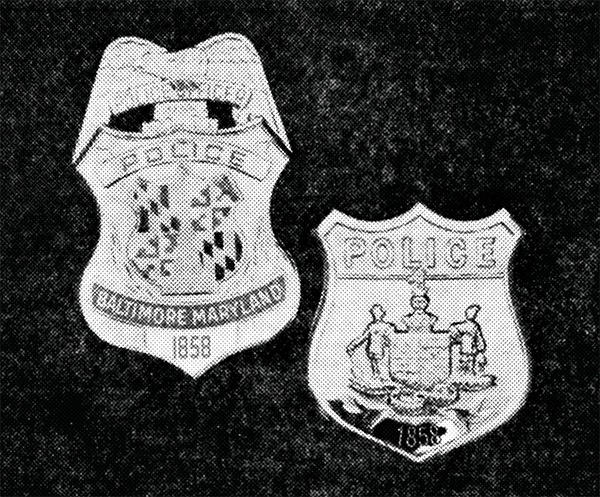
Photos Courtesy of Ret. Det. Leo Smith
New Badges for City Officers
![]()
Commemorating the 200th. ANNIVERSARY
of the
BALTIMORE CITY POLICE DEPARTMENT
The Baltimore Police Sword was made available in 1984 to members of the department. The sword is 34” in length, Made by the Wilkinson Sword Company in England with engraving on the blade of important events within our agency’s history from 1634 thru 1976. Also engraved on the blade are the 5 badges our agency used since our beginning.
There were only 152 made, sword number 1, went to Commissioner Bishop Robinson (Actually to the office of the Police Commissioner at the time) number 152 went to the Baltimore Police Museum. Currently we don't know where either of those swords are. We do have in our personal collection sword number 081. A kind of funny story when we bought this, Ken had been wanting a sword for a long time, so when he heard one was available, he struck a deal to buy it along with a call box, some Park Police items, to include badges, droop awards, pictures, a tag plate, and other items. Most of it was high dollar items, call boxes can reach a $1000 or more, Badges near $200, the Park Police Awards were rare so $100 or more each and there were two awards, the Tag Plate was valued at $125, the Pictures $25 to $150 each, and that BPD Sword can bring as much as $1200 to $1500. So, it was all valued around $3000. The seller gives Ken deals and agrees to sell it all in a lot for $1800 then he threw in a really nice show case for the sword. The guy was going to let Ken make payments, but I had some cash set aside for emergencies, and to me nothing is more important than to see Ken happy, So I wrote the seller to let him know we would pay the entire dollar amount and could come pick everything up when it was best for him. We ended up going that night after dark, and just paid for everything loaded it into our truck and came home. The next morning, we went out to unload the truck, our son was with us, and the first thing Ken went for was the sword in that really nice show case. Immediately he noticed there was no etchings, so he looked concerned, but he knew the seller, so he assumed it was a mix up, then he asked our son to look and see, if he could see, a serial number, "yes" he said, "it is 180" What wait... 180? and again our son confirmed, "yes, it is number 180!" This was a concerned because as you might remember from earlier in this article, there was only 152 swords made, but you might also remember, we said we have sword number 081, as it turned out the sword was in the case backwards, the etchings were in the back, and our son was reading the number upside-down.
Click HERE to Learn more about the BPD Sword
![]()
Retired Badges
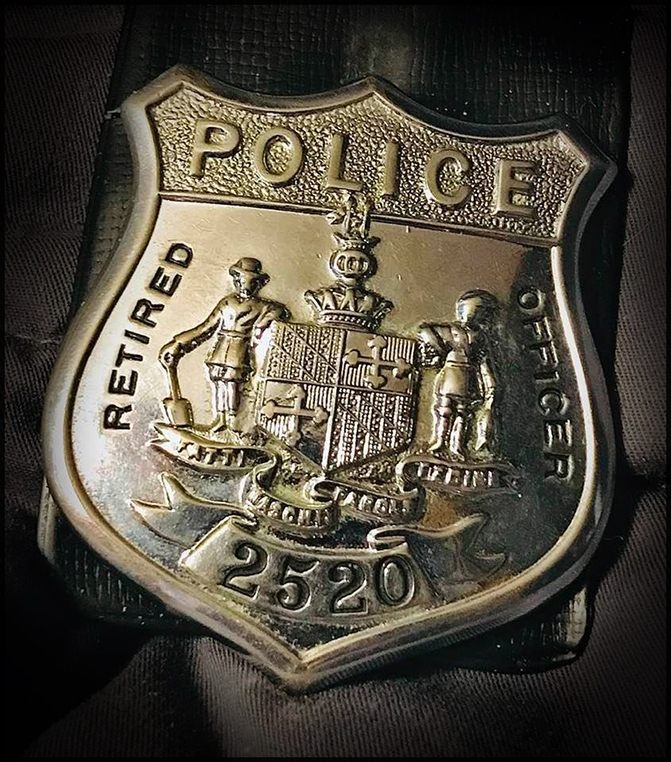
4th Issue Retired Badge
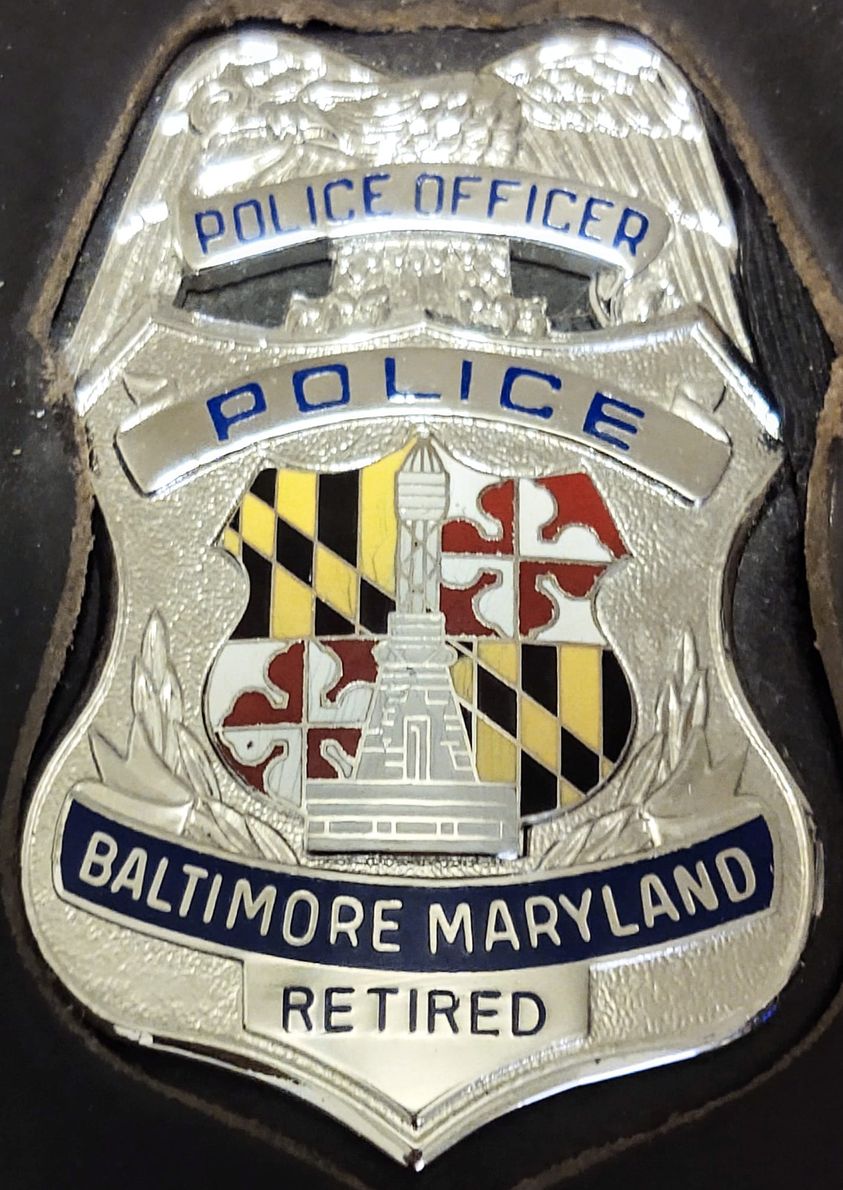
5th Issue Retired Badge
![]()
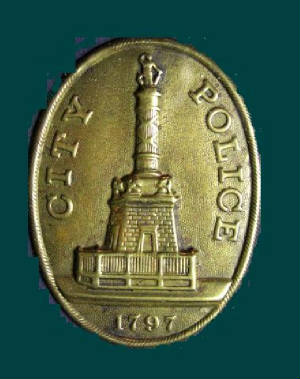
1850 CENTERPIECE OF THE STAR.
NOTE: This has a pin & catch on the reverse.
There is wear to this badge, however, there were never any star points applied due to the lack of solder on the reverse.
*Rumor says this may have preceded the star as the first badge. Only a few of these exist.
Actual Baltimore Police badge was worn by Detective Albert Gault, who was a Baltimore City Policeman and Detective from 1866, when he joined the force, until his death in 1900. Detective Gault was a celebrated Detective who was involved in numerous cases during his tenure. The book, entitled "Our police: a history of the Baltimore force from the first watchman to the latest appointee", by De Francais Folsom. Chapter X has about twenty pages detailing some of Detective Gault’s cases.
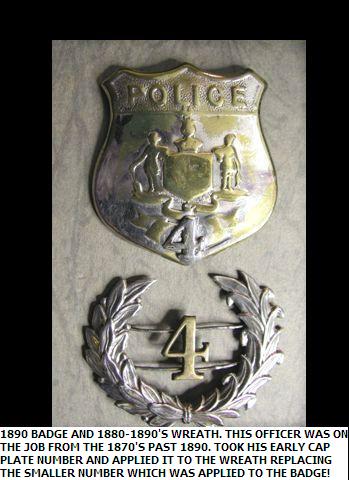
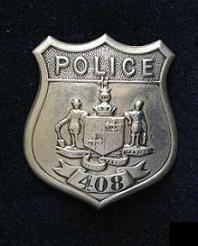
Above is the early issue badge
Below is the later version after the mold had broken and was reinforced. Note the shelf under the fisherman's arm on the right arm
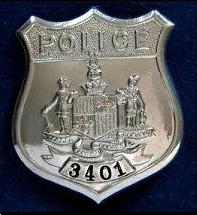
Below is a matched set of wreaths and a badge dating from 1890 through 1915 and afterward. These were assigned to Officer James E. Schmidt of the Northern District. Officer Schmidt was appointed in 1894 and served until 1923. Featured are his original badge# 682, the 1880 type wreath# 682, and the 1896 wreath# 682 and the 1915 hat device# 682 that is still in use today.
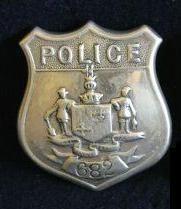
Above is the badge being issued around 1890
Badges were made by the Irvin Hahn Company, Baltimore, Maryland Still in Business to this day suppliers of our awards, Medal of Honor and Valor
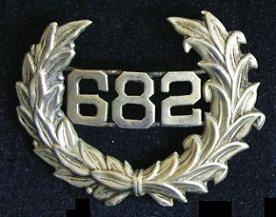
Above the Wreath style of 1880-1896
Below the Wreath style of 1896-1908
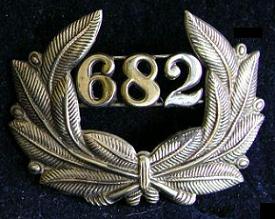
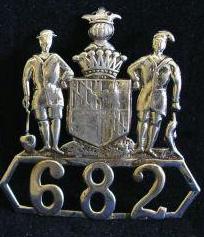
Above is the style of hat device 1908 - Present
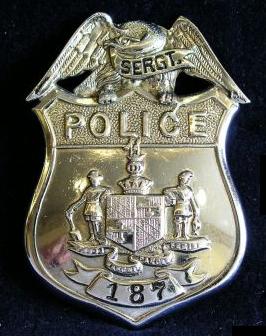
Sergeant’s badge from the 1920’s. The earlier construction of these badges had a separately detailed eagle mounted on the top. Note the talons overlapping the top rim of the badge. This denotes an 1890 pattern.
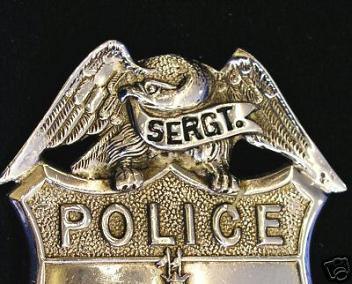
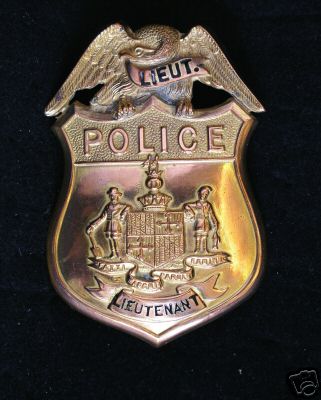
A very rare early 1900’s period Lieutenant’s gold badge. This early style of badge had the detailed eagle separately applied to the top. Notice the overhanging talons grabbing the edge. The lettering is hard enamel and stone ground to make the lettering flush with the surface. This was an option Hahn Company offered with their badge construction. This was the most expensive way to produce the badge
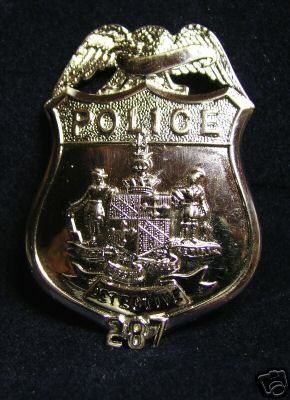
Early DETECTIVE Badge with applied number (above)
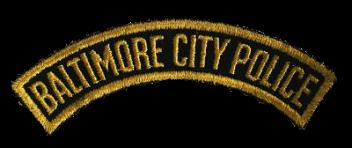
Original shoulder patch of the 1950's
Another interesting set including the very early issue badge #187 and the matching hat devices used from 1880 through the present day.
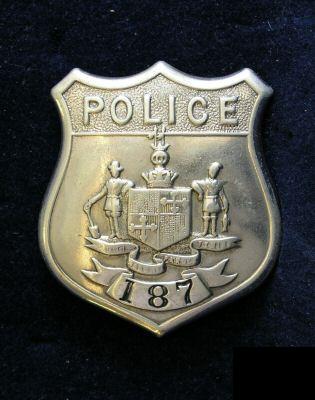
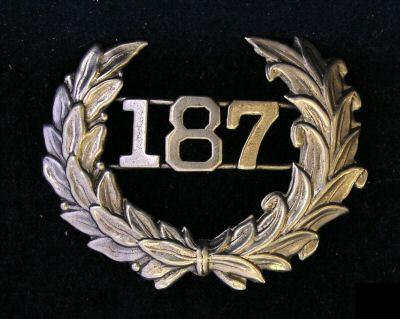
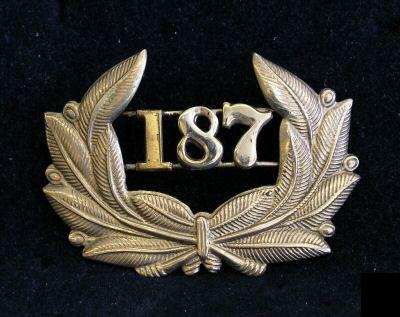
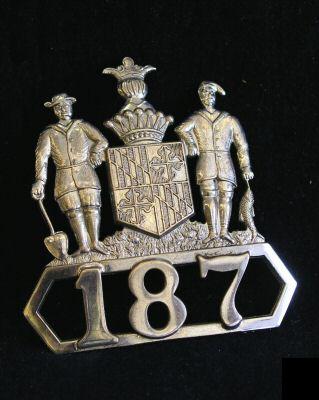 Photos courtesy of Retired Major Robert DiStefano
Photos courtesy of Retired Major Robert DiStefano
Medal of Valor, and the Legion of Merit.
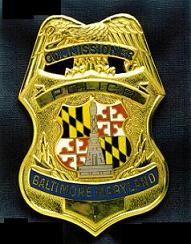
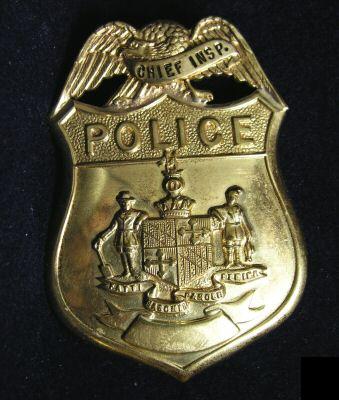
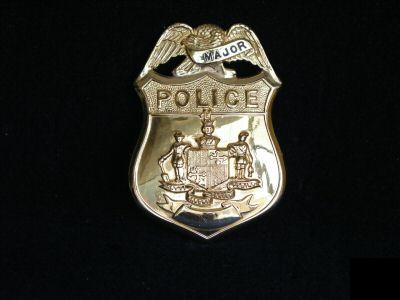
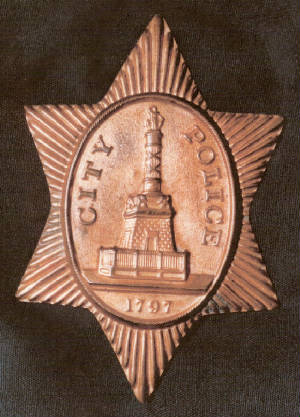
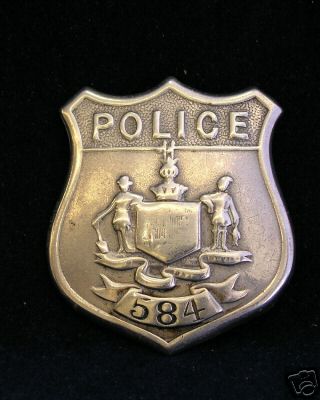
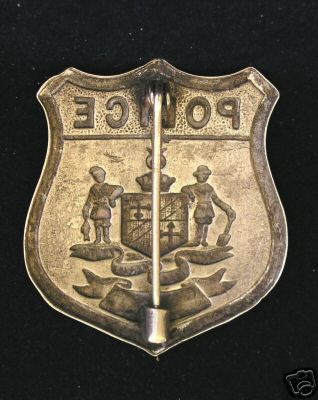
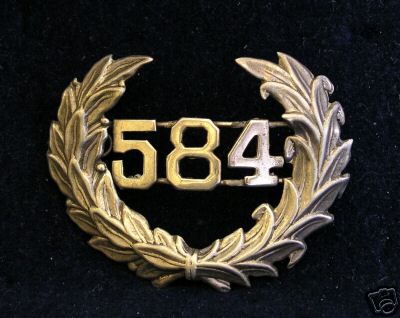
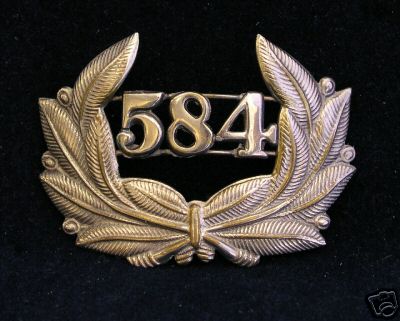
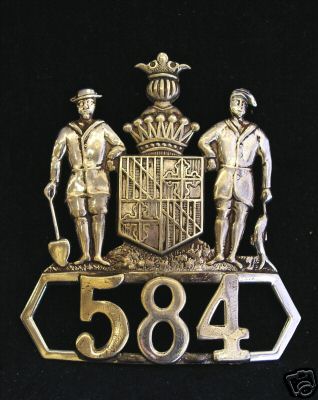



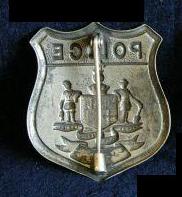


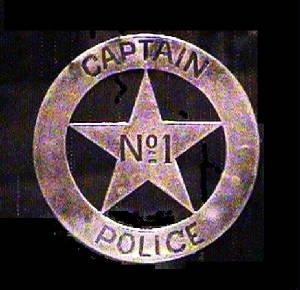
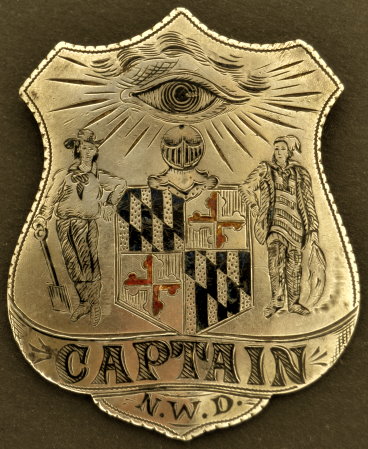
Friday Aug 20, 1886 new badge
New badges for the police captains – today the captains of the police force of the city will appear with new badges. The police board having issued an order to that effect. For some time past, Marshall Frey states, the captains have complained that their old badges were identical with the badges worn by nearly every private detective or watchman in the city. The old badges were simply a star within a circle, with the words “Capt. of police” on the rim. The new badges are much more elaborate and are very handsome. The form is a shield, about 2 ½ inches long and 2 inches wide. Of silver. The Maryland Coat of Arms is and blazoned on the face. An “eye” is engraved over the coat of arms. The word “Capt.” appears below. The new badges were made by Mr. John W. Torsch. Marshall Fray says that the force being a state institution, he thought it appropriate to have placed the Maryland coat of arms upon the badge. He further says that the “eye” is intended to remind the captains that their duty is to be always on the alert.

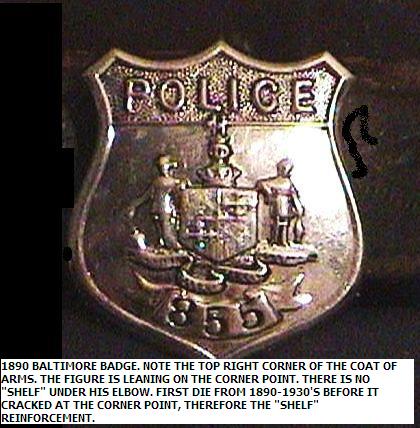





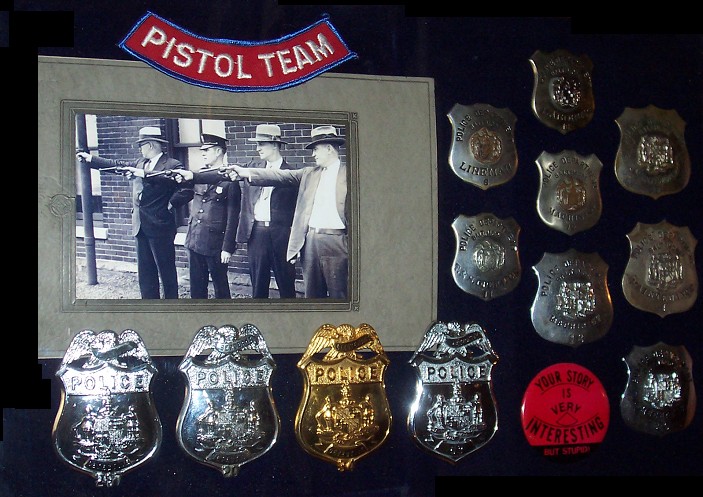
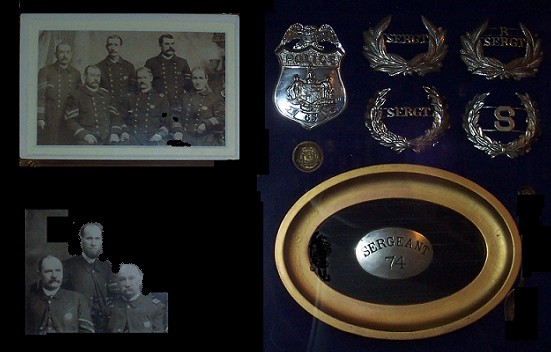
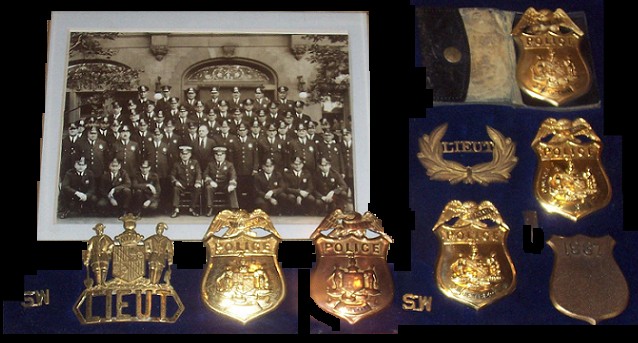
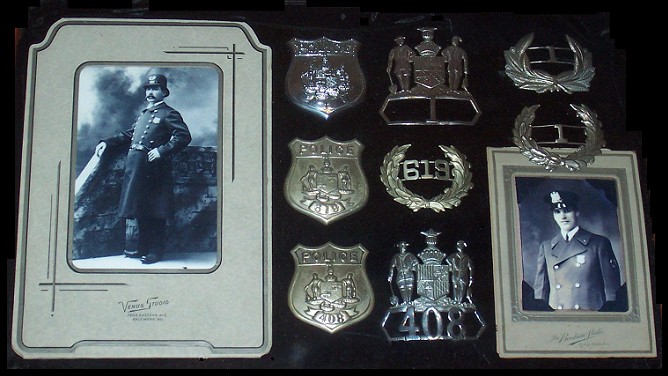
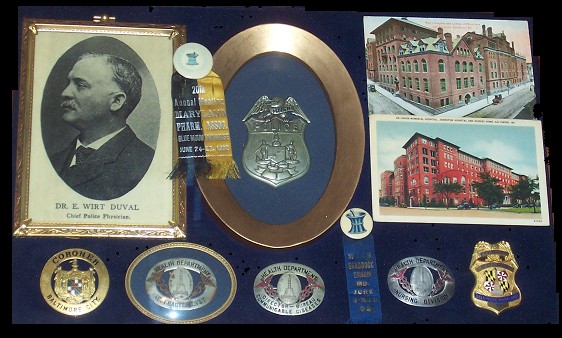


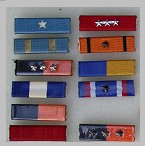
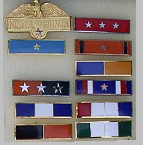
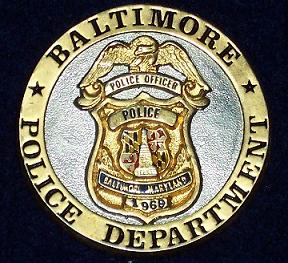
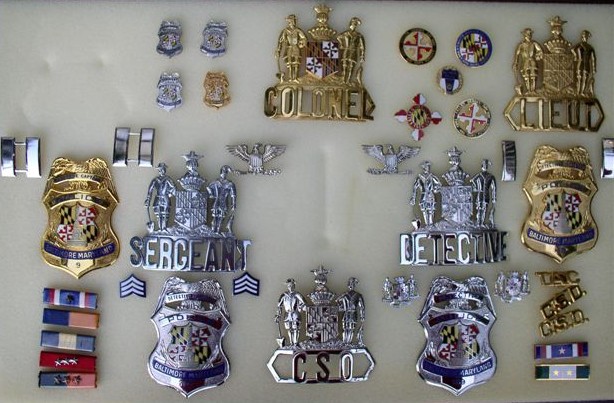
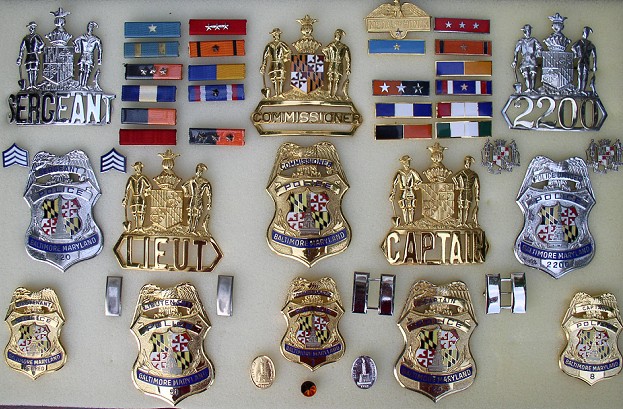
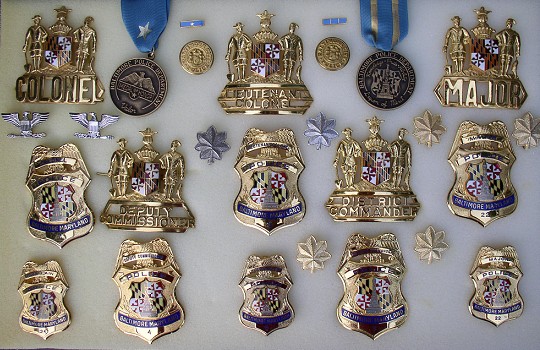
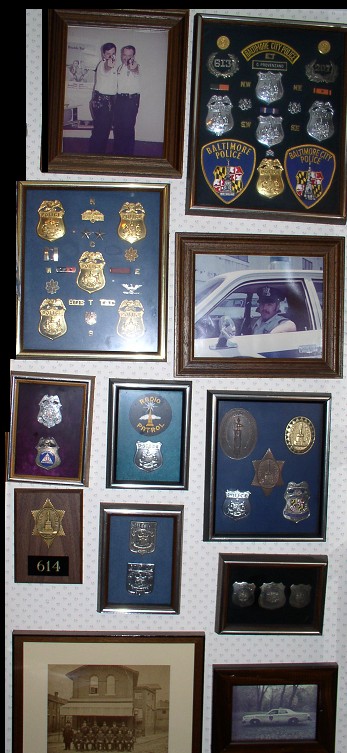
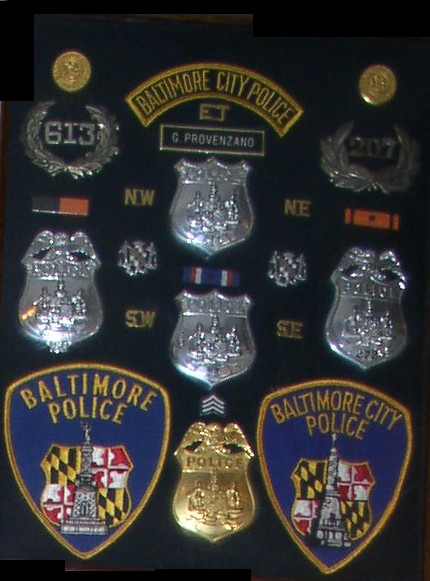
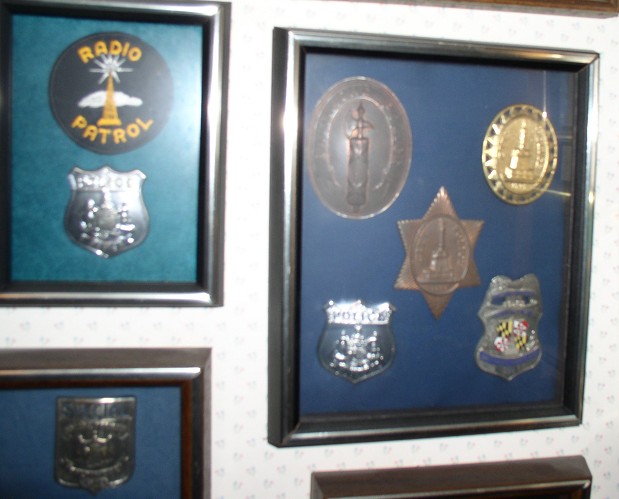
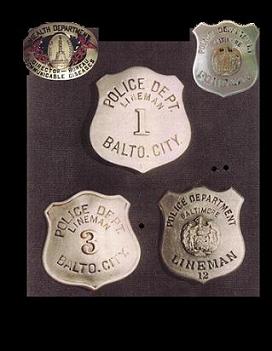
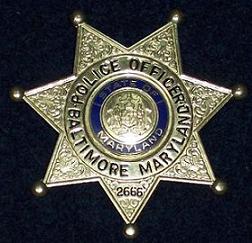
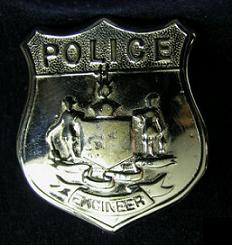
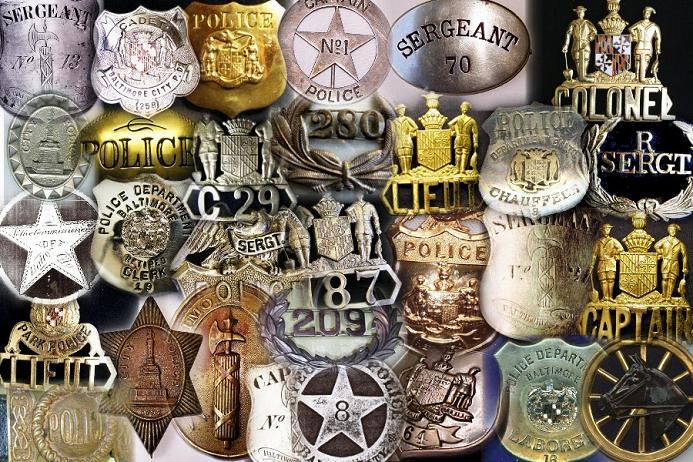
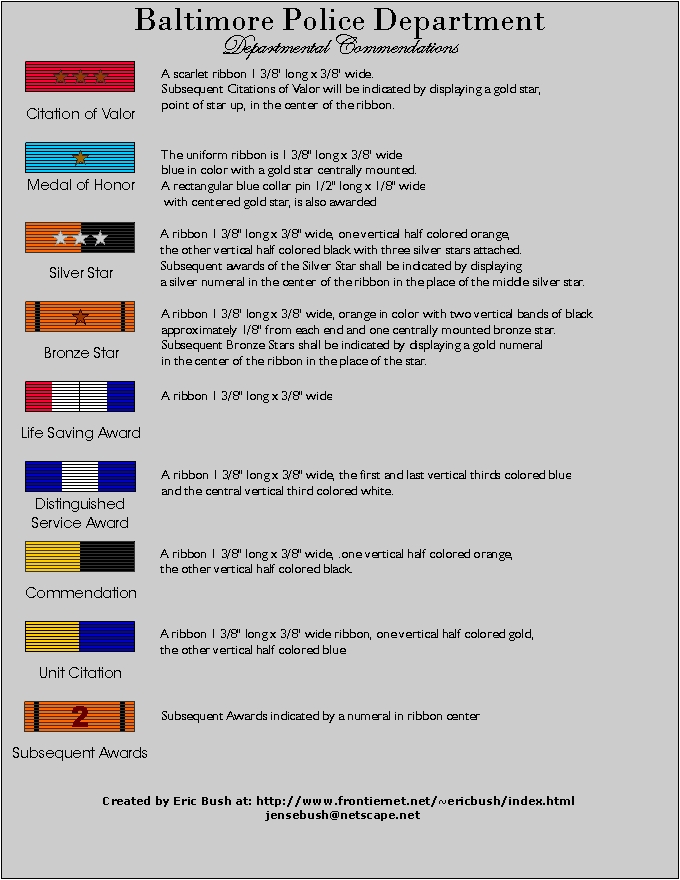
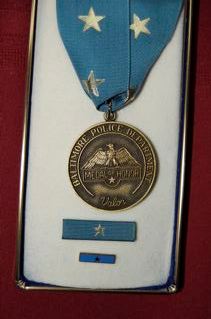

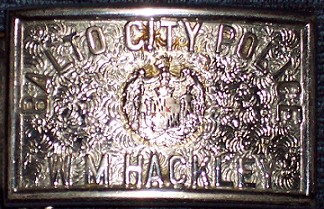
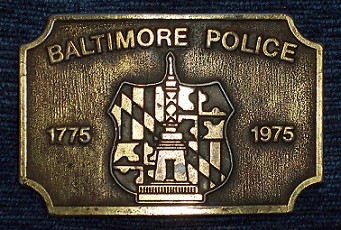
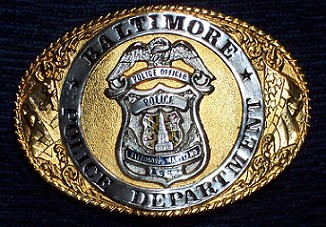
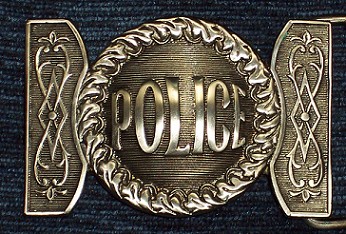
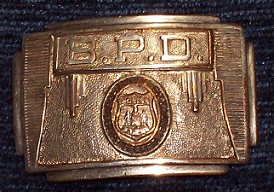

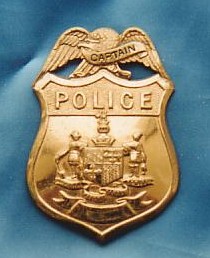
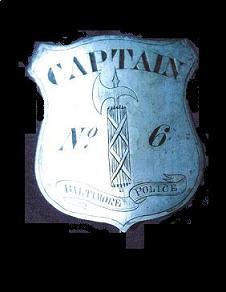
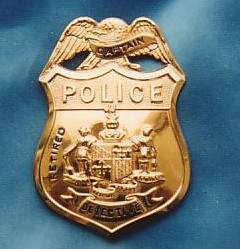
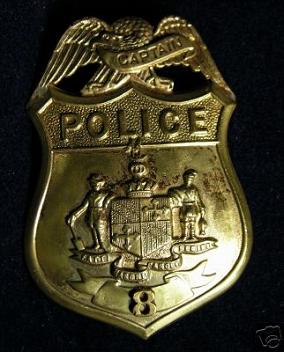
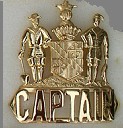
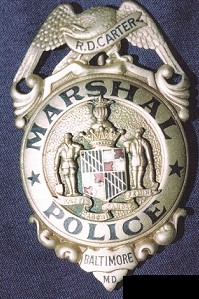

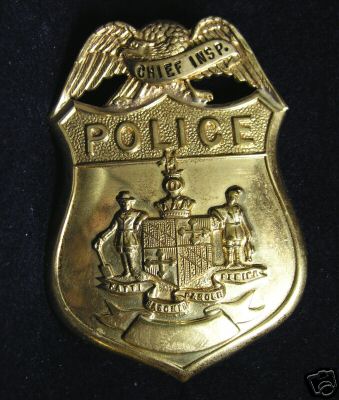
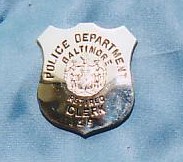
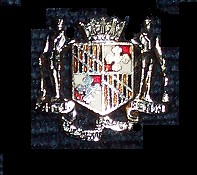
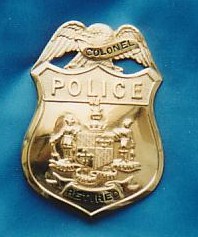
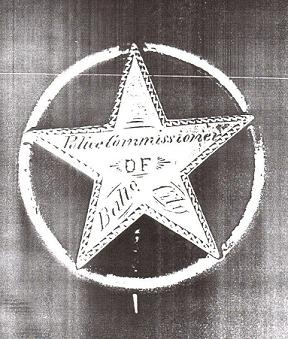
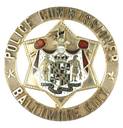
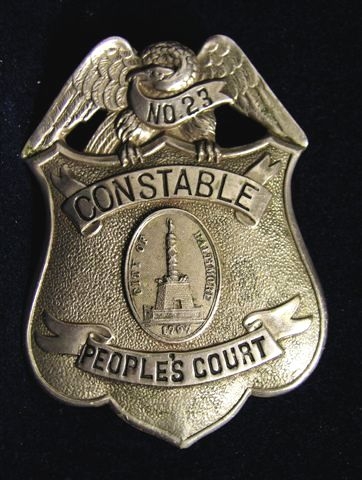
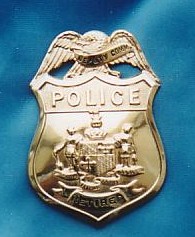
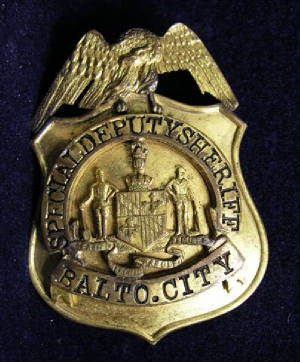
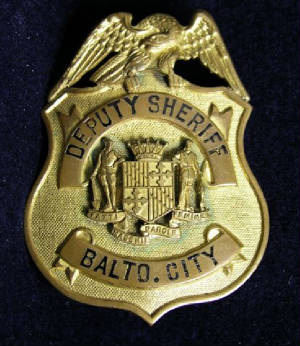
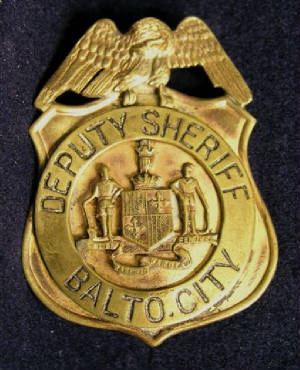
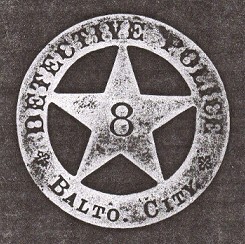
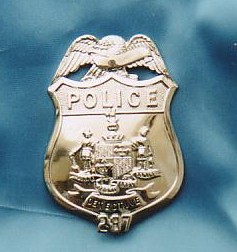
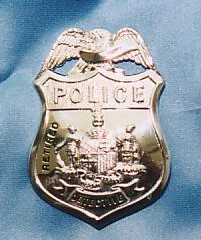
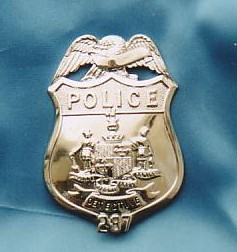
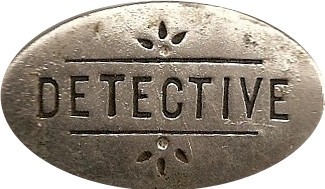
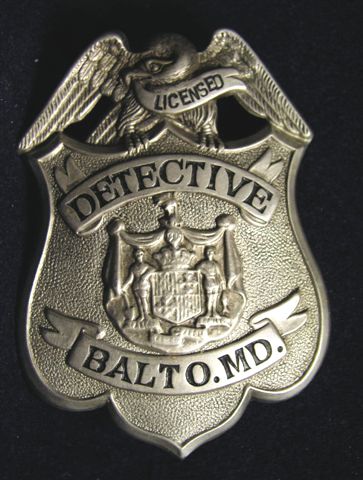
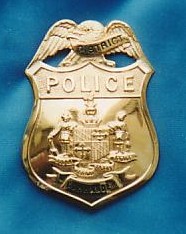
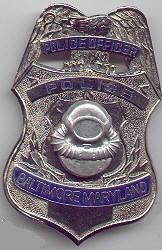

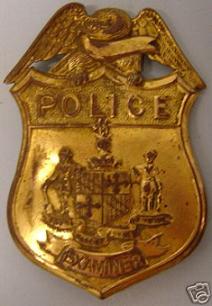
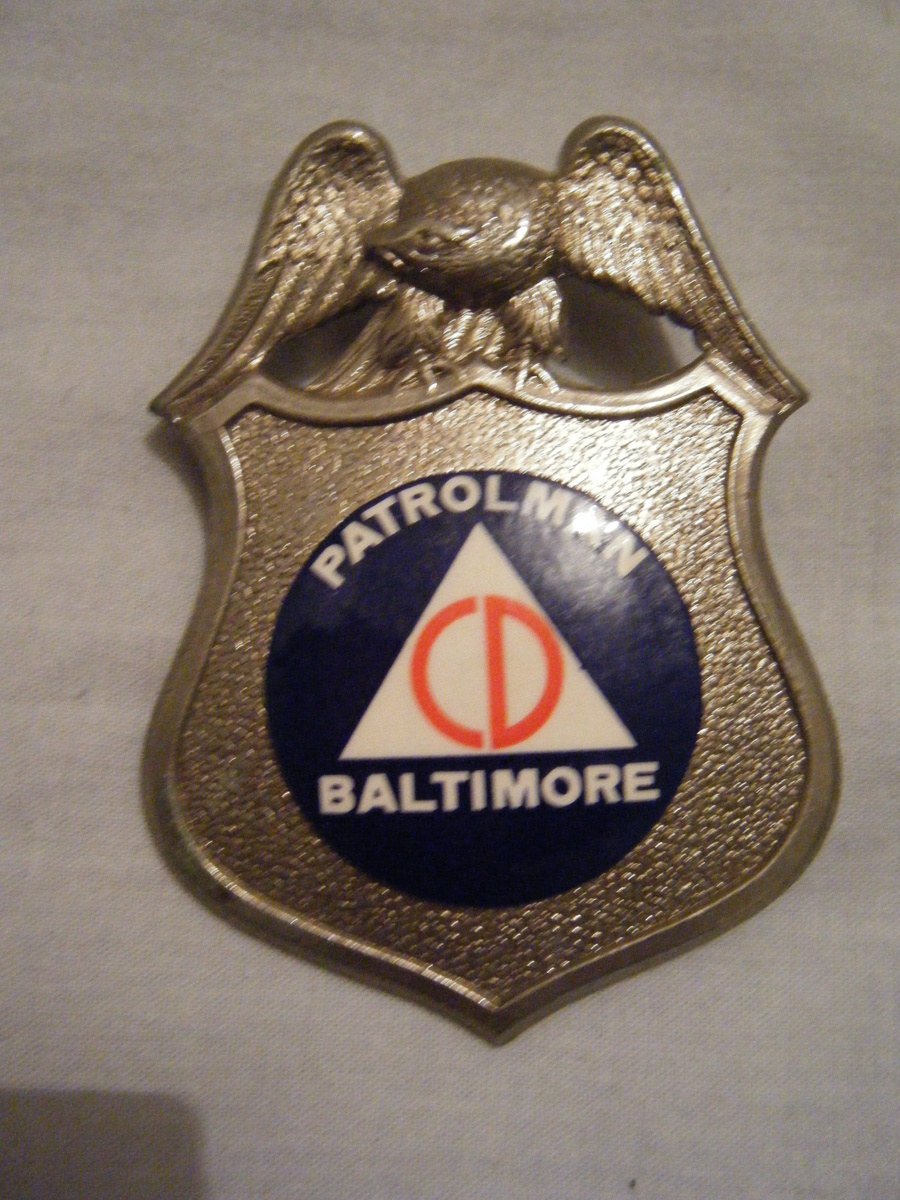
This is an Obsolete Civil Defense Patrolman Badge for the City of Baltimore. The badge is stamped metal with an Eagle over a shield. The center of the shield has an enameled roundel with the Civil Defense emblem on a blue background. Around this is Patrolman and Baltimore. "BASTIAN BROS/CO/ROCHESTER NY".These badges were intended for police personnel acting under Civil Defense authority in an emergency situation and are a neat Cold War memento.
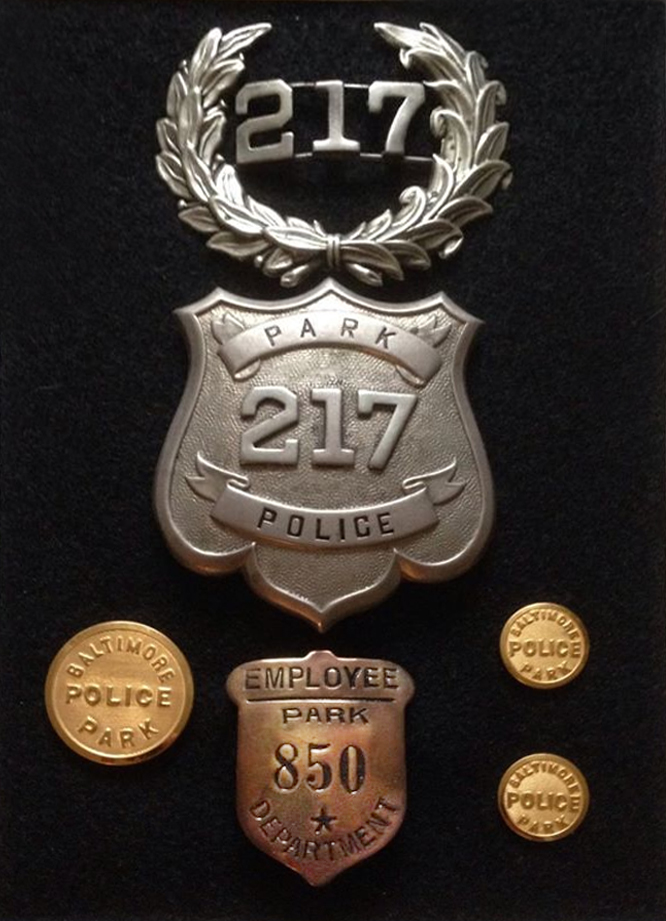
Courtesy Patricia Driscoll
1920 Park Police Matching Badge and Hat Device
![]()
 Retired Badges
Retired Badges
There were said to have been four retired Baltimore City Police badges—well, three—but Ken found a 1957 newspaper article in which the commissioner swore a 6-year-old boy as a Baltimore Police officer and issued badge number 390. Within a year of this swearing in, the young boy died. At his funeral were politicians, the police commissioner, and more than six uniformed Baltimore officers. They gave the boy a full police funeral, with six officers acting pallbearers. On January 30, 1957, as Commissioner James Hepbron gave his speech, he announced the young Officer Vincent Felicebus, Jr's badge #390 would be retired and never again used by any officer of the Baltimore Police. - We are not 100% sure, and only recently did we start to research the retired badges, their numbers, and the officers that carried them before they were retired. Of the three badges, we heard of them on May 6, 2018, and I should point out that, before May 6, 2018, both Ken and I only thought badges were retired to officers that had made the ultimate sacrifice. Right after Commissioner DeSousa retired Ken's badge, we went to the Candlelight vigil, and someone approached Ken, asking how many others had their badge numbers retired. Officer Bobby Brown answered for Ken, telling the guy there were four. Bobby later corrected that number, saying there were only three, including Ken. Ken thinks it should be four because of a newspaper article he found in the Baltimore Sun mentioned earlier in this paragraph.
At the candlelight vigil, I saw the same guy, and I am sorry I did not get his name or recognize him. Other than knowing he knew Ken, or at least, by the way, they greeted each other, it seemed they were friends. Anyway, he asked Ken if he knew any of the others that have had their badges retired, and again, Officer Brown answered, saying the officers he knew of were "Mad Dog." Ken said, Mad Dog, is Detective Albert Marcus. At that point, we knew or believed we knew that there were five officers, and we now had the names of two of the three identified. We just need the numbers of the other two badges [Det Marcus, P/O McAndrew]. Ken turned to his favorite source of information and learned of Officer John McAndrew, retired on June 30, 2011, - Badge, retired by Commissioner Frederick H. Bealefeld III. After McAndrew came Detective Al Marcus, retired on March 5, 2016, - Badge, retired by Commissioner Kevin Davis. Then came Ken's Detective Badge #550, retired on May 6, 2018 by Commissioner Darryl DeSousa. Retired before any of these occurred in 1957 when 6-Year-Old Honorary Officer Vincent Felicebus, Jr. - away on January 30, 1957, when Badge # 390 was retired by Commissioner James Hepbron. We were contacted by the son of a retired officer who himself served with the Baltimore Police, and he told Ken his father retired under Bishop Robinson circa 1967/68 after 35 years service and at the time of his retirement, Commissioner Robinson told his dad he would have his badge, badge number 23, retired so as far as they know Retired P/O Edward A. Panowitz Sr. had badge number 23 retired in his honor by Commissioner Bishop Robinson
Ken found this and the young boy almost instantly in his first search, and a second article made Ken realize this was the fourth retired badge of the four badges, and we know this because in the article the writer wrote,
"McAndrew's official police badge will be retired, only the third such badge to be removed as a form of honor and recognition."
If McAndrew had no one before him, he was obviously #1; Det. Marcus retired after P/O McAndrew, so he had to be #2; and Ken just happened, so that was easy enough for #3. Police Officer Vincent Felicebus, Jr., was an honorary officer. To Ken, this puts young officer Felicebus in as number one and moves the rest of the list down by one. So now McAndrew is second, Al Marcus is third, and Ken is fourth.
As with everything we do, we could use our readers help. If you know anything about any of the retired badges, we could use actual badge numbers for the officers. But, until then, we all know it takes a lot to get any kind of recognition, so as Ken said, at least four of them had to have been extra special.
Also, if you know of a different name, maybe Number #1 isn't for an honorary police officer; other than Ken's and McAndrew, we really don't have any documentation or information on the others. We have one more newspaper article, but it doesn't say the badge was retired. With that, though I did talk to his son, who said it was retired, technically, he didn't say it was retired; all he said was that he has the retired badge and the badge with his dad's badge number. I figure the only way to have the badge with the numbers on it, and for a guy who served 50 years, if it wasn't retired, it should be. There were a lot of stories about the six-year-old that passed away. Commissioner Hepbron gave him the badge a year before his passing, and when he passed, the Commissioner attended his funeral and had uniformed officers stand in as pallbearers. There were several other politicians also in attendance.
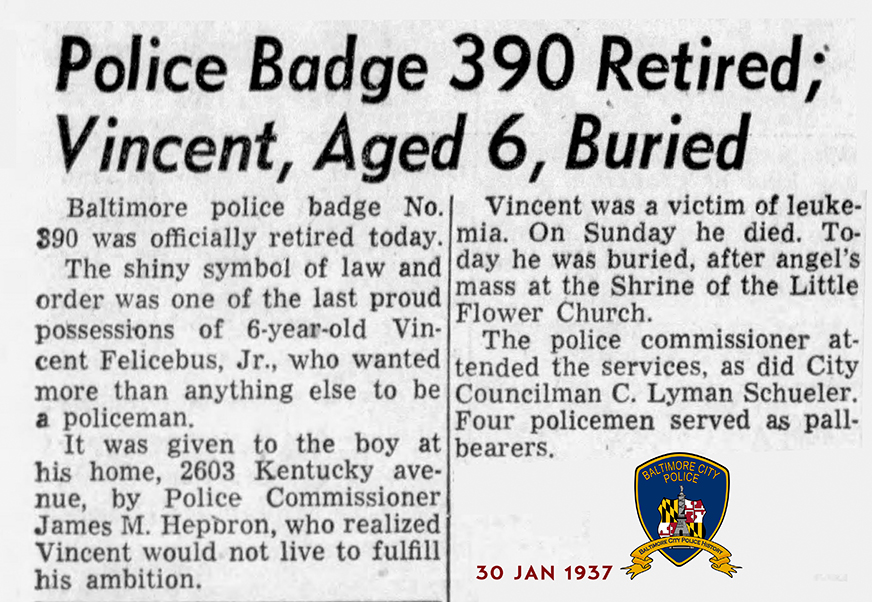
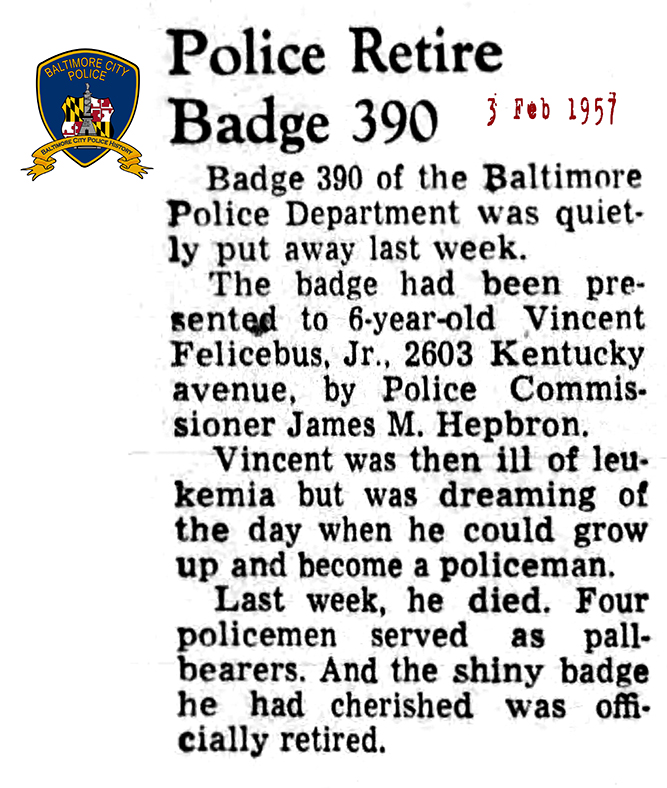
![]() Retired Badges
Retired Badges
The retirement of a badge number is one of the highest honors in law enforcement, a tribute that encapsulates the character, contributions, and impact of the officers who wore them. It is a testament to their exceptional service, dedication, and influence on the department and the community they served.
Typically, this honor is bestowed posthumously as a final salute to fallen officers. However, in rare and extraordinary circumstances, it is granted to living officers. Since 1785, in Baltimore, only five living officers, including three officers and two detectives, have received this distinct honor. This rarity underscores the magnitude of their contributions and the deep respect they’ve earned from their supervisors and peers.
Retiring a badge number ensures that it is forever associated with the officer or detective who wore it. It becomes a symbol of their resilience, their pursuit of justice, and their unwavering commitment to their duty. It’s a legacy that will inspire future generations of law enforcement officers, reminding them of the profound impact one person can have on the department and on the community.
In essence, the retirement of these badge numbers is not just an honor but a lasting tribute to remarkable careers and extraordinary individuals. It’s a testament to the kind of officers they were and the enduring legacy they left behind, while hopefully inspiring others to follow in their footsteps and continue the noble tradition of service and dedication to protect and serve their communities.
These retiring officers have set a high standard for professionalism and dedication, serving as role models for their colleagues and the community. Their retirement marks the end of an era, but their influence will hopefully continue to be felt for years to come. As new officers look at their badge numbers with a new kind of respect, they might carry on the tradition of excellence and strive to make a positive impact, just as these remarkable individuals have done throughout their careers.
There are said to be four retired police badges; we are not 100% sure of the four, but we know of a possible fifth badge. From what we do know and have heard, five badges have been retired, four for our officers, and a six-year-old honorary police officer.
1957 - Honorary Police Officer, 6-Year-Old Vincent Felicebus, Jr.; 30 January 1957: Badge # 390: James Hepbron
1968 - Retired P/O Edward A. Panowitz Sr, 1968: Badge # 23: Bishop Robinson
2011 - Retired P/O John McAndrew; 30 June 2011: Frederick Bealefeld III
2016 - Retired Det Al Marcus; 5 March 2016: Badge # 12: Kevin Davis
2018 - Retired Det Kenneth Driscoll; 6 May 2018: Badge # 550: Darryl DeSousa
- Retired P/O Gerard Heid, Badge # 2407
- Retired P/O Edward A Panowitz, Sr., Badge # 23
![]()
The following speech was written by Mike May and used in Ken's 2016 Officer of the Year Award, but with some modifications. It was enlarged, so when printed, it took as many as 5.5 to 6 pages. The commissioner skimmed over it, pulling parts he had highlighted and read. Someone handed the speech to one of our kids, and I had it added to the site for you to read it in its entirety, as well as just the parts the commissioner read. Ken spoke with Mike May at the event, and Mike told him he re-wrote it for the commissioner.
The honor of having his badge retired was for a large framework of actions Ken has taken, including his 7 Officer of the Year Awards, bringing Statement Analysis to the agency in 1993; having been injured to a point where he became the first Baltimore Police Officer to have received PSOB benefits for a line of duty injury (that alone shows the severity of his injuries). To continue; the honor was for his raising funds to help officers in need; helping other officers file for and receive PSOB funds, two citations of valor, and other recognitions officers have long deserved, like helping more than a dozen officers get their citations of valor ribbons retroactively; Ken also works to make sure the fallen and injured are remembered. He works to research and share department history through Facebook posts, Twitter, and the History site here at www.BaltimorePoliceHistory.com. Ken also had a role in having the museum reopened and holds a lease through City Hall on the lobby area that houses the museum. He has always said, he could not have done the museum alone, but gave all he could, to have it re-opened. to include putting more than $40,000 of our personal collection on loan with the rest of our collection valued over $100,000.00 here and ready to be swapped in and out at the department's will. It was for all that; along with Ken's dedication to the department and, the men and women that have served, currently serve, and will someday serve. Neither Ken, or I smoke, drink, or have any costly habits. So, we put everything we can afford into research, and building a better website. and collection of memorabilia to put on loan to the museum. More than physical items, Ken finds information most valuable, so he continues to research, through newspapers, and old books written during the times he is researching allowing us a way of better telling the story of the Baltimore police.
![]()
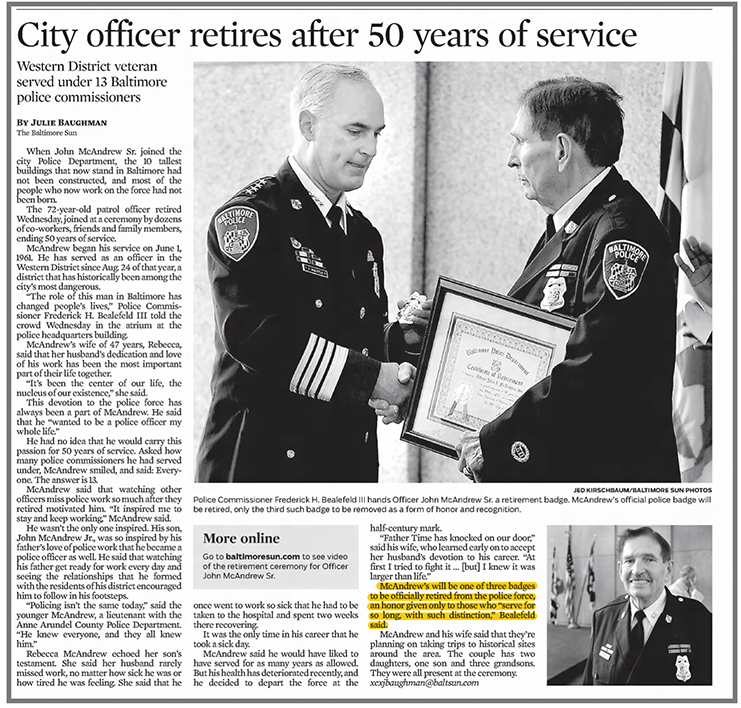
![]()
POLICE INFORMATION
Copies of: Your Baltimore Police Department Class Photo, Pictures of our Officers, Vehicles, Equipment, Newspaper Articles relating to our department and or officers, Old Departmental Newsletters, Lookouts, Wanted Posters, and or Brochures. Information on Deceased Officers and anything that may help Preserve the History and Proud Traditions of this agency. Please contact Retired Detective Kenny Driscoll.

NOTICE
How to Dispose of Old Police Items
Please contact Det. Ret. Kenny Driscoll if you have any pictures of you or your family members and wish them remembered here on this tribute site to Honor the fine men and women who have served with Honor and Distinction at the Baltimore Police Department. Anyone with information, photographs, memorabilia, or other "Baltimore City Police" items can contact Ret. Det. Kenny Driscoll at
Copyright © 2002 Baltimore City Police History - Ret Det Kenny Driscoll
